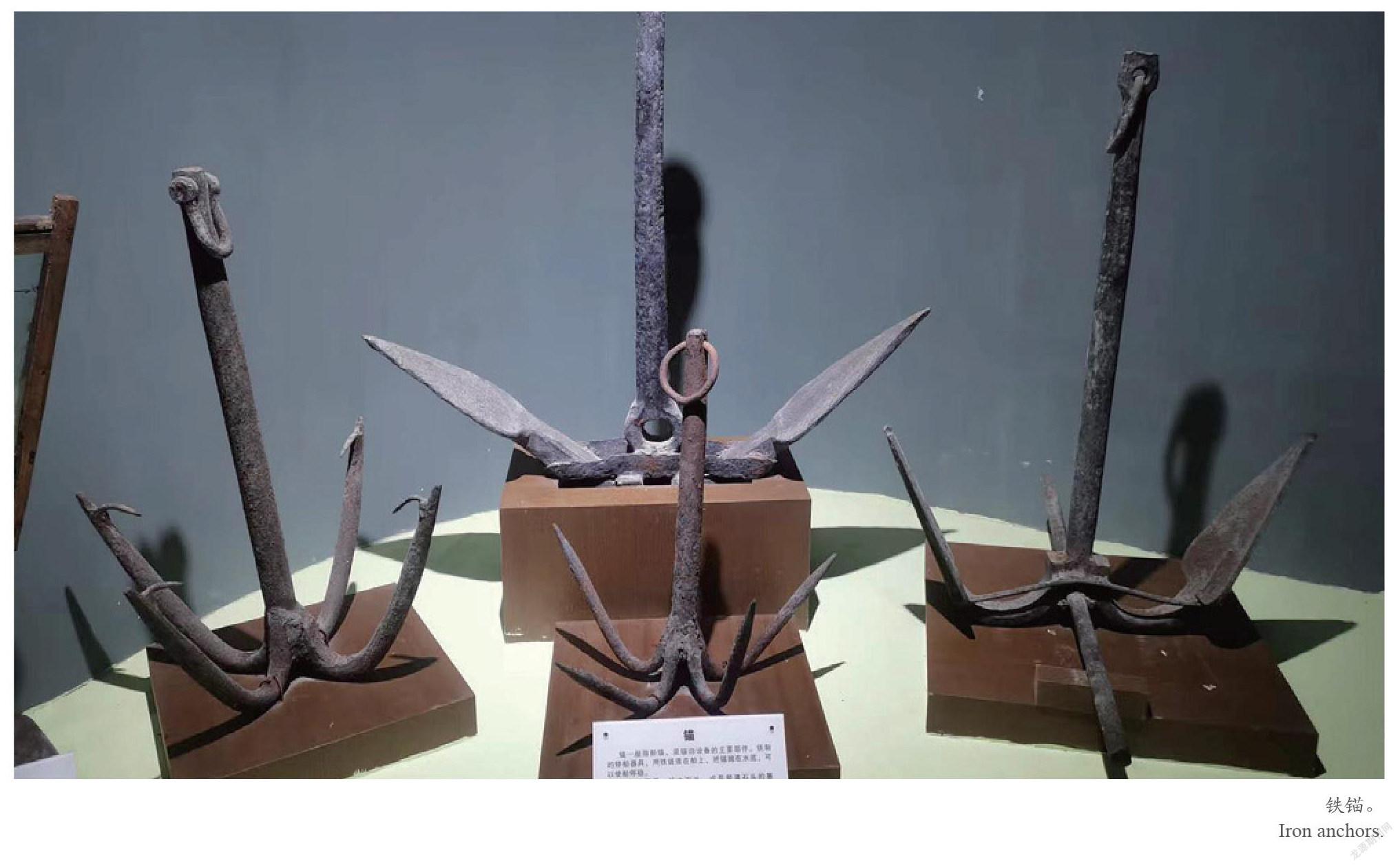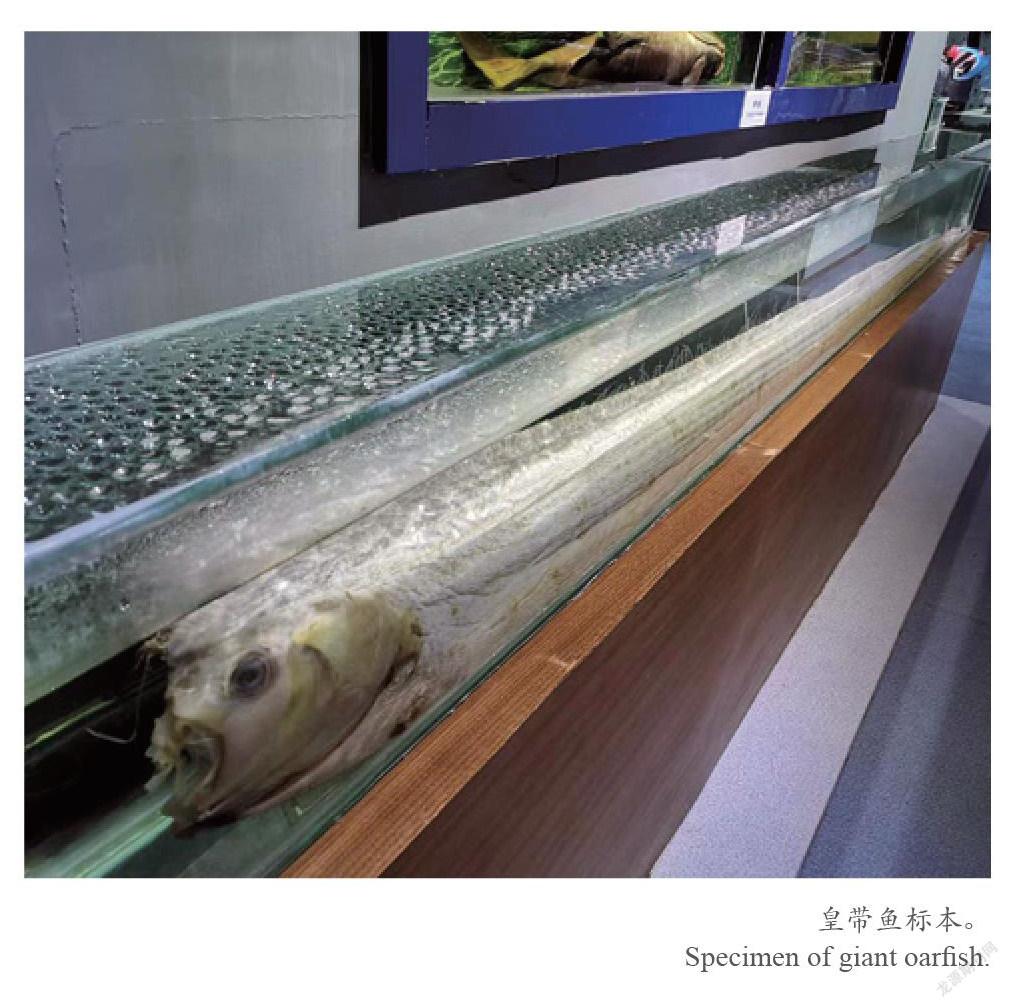50年“捡”出一座渔业博物馆
2022-06-30林上军
林上军



倘徉在舟山岱山岛东沙古镇古街上,循着古渔镇清悠的石板路,两边的街铺小吃,让人联想起儿时的记忆。
不知不觉,一座挂有“中国海洋渔业博物馆”匾额的老式民宅赫然展现于眼前。穿过厅堂,整洁的院落放置着原汁原味的渔业工具:粗大的渔网缆绳、牵拉网具的伏地虎、用于敲打桐油石灰的石锤。
古色古香的展馆内,栩栩如生的海洋生物标本琳琅满目,难得一见的大马鲛鱼、皇带鱼、海豹、翻车鱼、中华鲟、海龟等,还有大型海兽骨骼如须鲸下额骨、鲸鱼头盖骨、鲨鱼脊椎骨,以及贝类、藻类、珊瑚标本等。移步展厅,一艘艘木帆大捕船、机帆船、灯光围网船的模型扑面而来,渔家生活用品、民俗场景、渔民服饰展示,又令人感觉仿佛步入曾经的海岛渔村。
中国海洋渔业博物馆,已经成为古镇一个主要旅游景点。2004年,当地政府利用一座民国时期的四合院民居改建成了这座博物馆。馆内展品有1600余件,展品类别有鱼类贝类标本、渔业生产用工具、渔船仪器、渔民服饰等,物件配以文字、图片说明,整个陈列既是一部海洋文化演变史,更是一部鲜活的海洋渔业发展史。博物馆产品除个别外,绝大多数均由一个地地道道的渔民赵行法个人收藏积累而来,现与岱山县政府合作运行,供游客免费参观。
近几年,渔博馆年均接待游客量近10万人次。作为博物馆创办人,舟山市岱山县高亭镇闸口一村老渔民赵行法50年来靠“捡”,硬是“捡”出了一个渔业博物馆。
赵行法年逾花甲,出生于一户贫困的渔民家庭,他12岁那年,作为家里主要劳力的父亲在海上作业时落海身亡,家庭经济状况雪上加霜,当时穷得连给早年去世的奶奶入葬的钱都没有。赵行法14岁辍学,与母亲拉手拉车搬运水泥、红砖,从东沙泥峙至高亭,每天2车,有时3车,每天劳动时间达11小时至18小时,其中艰辛难以用文字表述。他17岁时,春节后便下海捕鱼,在渔船上做了两年多“火浆囝”(渔船上炊事员),因表现突出,他被提升为船上大管轮(轮机长助手)。
随着渔船设备的持续更新,渔业资源的不断变化,小学毕业的赵行法感觉到,与渔有关的设备投入大、淘汰快,如果不及时收藏保留,下一代人就无法知晓无法了解,渔文化就会断层,东海渔场、中国渔业、舟山渔村的积淀就无从谈起。于是,他在艰辛的劳作之余做起了有心人。
在博物馆二楼,他指着一木舵跟笔者说,这种木舵原先只有木帆船才有,后延用到木质机帆船。20多年前,他在岱山县高亭镇某渔船老大遗弃的渔业村角落看到一扇完整的木舵,觉得应该收藏,于是拿出300元钱,托木舵主人的哥哥转买下来收藏。想不到数月后,木舵不见了,估计是被原主人“偷去”了。他设法寻找后发现,果真是被这位小心眼的原主人“偷”了回去,原主人认为,该木舵一旦被作为文物收藏,是要让赵行法发财的。为了避免不必要的矛盾激化,他没有与该木舵原主人争执,但下决心要收藏该物件。于是他在舟山市内渔区四处打听,哪里还有这类物品。近一年后,有人终于向他提供信息,说嵊泗绿华岛有这类物件。他马上托人用小船装过来,买价300元,运费600多元。而当时他一年的收入才数千元。
“这条大马鲛鱼是花费3000多元买来的。”他指着长2.50米、重达125公斤的一条栩栩如生的马鲛鱼标本回忆道 :2004年年初,縣政府正在动员赵行法将原先陈列馆“海曙楼”展藏的渔业文化系列整体搬迁到东沙古渔镇,创建“中国海洋渔业博物馆”。他从《舟山晚报》看到,普陀沈家门鲁美鱼粉厂收购了一条75公斤重的马鲛鱼。他迅速通过媒体记者打听到这家冷库相关人员的联系方式。对方见他求鱼心切,讨价六七千元,他一算,仅防腐等标本制作就要花上万元,于是讨价还价。因为手头资金紧张,一下子没有谈妥。几天后,有人告诉他,岱山一冷库还有比这更大的马鲛鱼,他喜出望外,果然有一条125公斤重的马鲛鱼,他决定不计代价也要买下该条巨型马鲛鱼。好在该老板没有漫天要价,只收了3000元,但加上标本制作等费用,最后仍耗资上万元。该事件经岱山电视台新闻报道后,感动了大家,县里认为,在“海曙楼”渔文化展藏品已决定搬迁东沙配合政府创建“渔博馆”的时候,赵行法还自己耗资上万元收藏渔标本,确实不容易。为此,安排县委办公室管小军副主任专门看望赵行法,并拨付县长基金1万元予以奖励,使赵行法深受鼓励。
“这条叉尾带鱼是中国现存三条样品中的第二条,并且是最完整的。虽然个体小,但很有特色,很珍稀,难得一见。”他指着鱼类标本一一介绍说,这条皇带鱼,长3米,重16公斤。“当时我还哭过。”他说,由于在冷库保存时冰冻很硬,拿出来要制作标本时带鱼头部两条长须及部分头部粉碎、脱落了,无法修复。“心疼啊,否则样子还要好看。”
1995年,他在自造房屋160多平方米的家里率先建起个人藏品展览馆,名曰“海曙楼”,著名经济学家、上海文史馆官员朱龙湛先生专程从上海来岱时历时20多天为他设计布置了展馆。
1997年,香港回归祖国之年,岱山县高亭镇政府打造了一艘10来米长的木质渔船模型,以示庆贺。一年多后,有渔村干部提议把该船模送到庙宇放置。他闻讯向宋忠道镇长要求由“海曙楼”收藏并获得同意,后用专门制作的近2米长的另一艘船模进行置换。现在渔业博物馆内有多艘船模,就是他这样一艘艘积累起来的。
在一个角落里,笔者发现有三只木制大桶。赵行法说,这桶是过去渔民用来放腌制后晒干的鱼鲞的,现在民间已经找不到了。为了其中的一只木桶,他曾连续三四年去一户渔民家中请求卖给他。开始时,这户人家的媳妇和婆婆,相互推脱,不舍得卖。经过几年数次上门,婆媳俩终于答应。另外一条渔民出海穿的龙裤,也是他连续三年上一个老渔民家用50元钱加一块新布置换而来的。
随着赵行法收藏名气日响,当地一些渔民也经常会给他捎带一些物件、宝贝。如渔业博物馆镇馆之宝——几条长5米多的鲸鱼颚骨,就是邻村渔民专门从渔场给他装运回来的。
进入21世纪初,岱山县规划建造十大海洋文化系列博物馆。渔业博物馆是落户东沙古镇的。“渔博馆”里的展品基本上就是“海曙楼”原展藏品中的涉渔物件。这意味着,他辛辛苦苦近50年积累的物件,免费供观众参观学习。他认为这实现了他的收藏初心。3EE94A63-B282-4387-979C-06BC6E49070F
1986年至1992年,每年的8月中旬至12月中旬,趙行法在担任闸口一村驻上海渔场办事处负责人时,协调渔船的鱼货销售等服务工作,结识了许多文化名人,这为他收集各类物件开拓了文化视野。这些德高望重的科学家、艺术家等,如浙江大学原副校长王启东教授,第三军医大学原校长,中国工程院院士程天民教授,前中国驻印度大使、中国徐福研究会原会长李连庆教授,全国政协常委、中国科学院资深院士杨槱教授,中国科学院院士冯士筰教授等都曾为博物馆创建给予支持,并莅临指导。他们对赵行法弘扬中国优秀传统渔文化之举给予了高度赞赏。
赵行法还当了近40年村干部,从村主办会计干起,先后担任村委会副主任、村委会主任。在村民全力配合下,在各级领导的支持下,闸口村从经济薄弱村变为当地屈指可数的富裕村。近10年时间,该村老年社员的“退休生活补助费”从10年前的5000元(夫妻俩,下同)提高至目前的15000元。村级集体固定资产从40年前的负债到10年前的近亿元,到目前的纯资产超两亿元。他本人先后获评岱山县劳动模范、全国模范人民调解员、海洋文化名人等。
村里富了,村民口袋鼓起来了,但他自己由于购买各种涉渔老物件、鱼类标本等,目前还负债数十万元。尽管如此,他依然寻找一切机会继续收集各类渔业物件。2021年,他又花费3万多元,从一家收购站淘来了制冰企业用的液压机,从船厂买来正要被拆解的渔船柴油机等渔文化藏品充实渔博馆,而这笔费用占了他年工资收入的三分之一多。
一转眼,中国渔业博物馆已经设立18年了,它已经成为岱山乃至舟山最有底蕴、最具特色的地标之一。10多年前,一位领导在参观渔业博物馆后曾这样评价:“这个博物馆物件尽管都是个人收集的,但其味道及文化内涵不逊于那些投资数千万元的渔业科普馆。”这个评价,是对这位老渔民几十年如一日致力于弘扬中国优秀传统渔文化工作而不懈努力的高度肯定。
A Fishery Museum “Picked Up” in 50 Years
By Lin Shangjun
In the ancient town of Dongsha on the Daishan Island, Zhoushan, the snacks along the clean and leisurely flagstone roads of the ancient fishing town are reminiscent of your childhood. Here, an old-fashioned residential building is impressive with a plaque of “China Marine Fisheries Museum” on the wall. Across the hall, authentic fishing tools are displayed in the neat courtyard: thick fishing nets and cables, and stone hammers for beating tung oil lime … Inside the quaint exhibition hall, there are a wide range of lifelike marine specimens and large marine animal bones. Further into the showroom, youll find models of wooden sail fishing boats, motorsailers and light luring seine boats. In addition, fishermens daily necessities, folk scenes and fishermens garment display remind you of a former fishing village on the sea.
China Marine Fisheries Museum, reconstructed from a Republican-era courtyard dwelling by the local government in 2004, has become a major tourist attraction in the ancient town. The more than 1,600 exhibits, including fish and shellfish specimens, fishery production tools, fishing gear, fishermens clothing, are accompanied by captions and pictures. The whole display is not only a history of marine culture, but also a vivid narration of the development of marine fisheries. Except for a few exhibits, most of them are collected and accumulated by Zhao Xingfa, a genuine fisherman. Operated in cooperation with the county government and provided to the public for free, the museum has received nearly 100,000 tourists annually in recent years. Its founder Zhao Xingfa is an old fisherman from Zhakou village, Gaoting township. Over the past 50 years, he has just “picked up” a fisheries museum.3EE94A63-B282-4387-979C-06BC6E49070F
Born in a poor fishermans family, Zhao is now over 60 years old. When he was 12, his father, the bread earner in the family, died while working at sea, making the familys economic situation even worse. He couldnt afford to bury his grandmother. At the age of 14, he dropped out of school and endured untold hardships in making a living by carrying cement and red bricks on carts along with his mother. They worked 11 to 18 hours a day to finish two or three cart rounds. His fate changed at the age of 16 when he started to work on a fishing boat. Due to his outstanding performance as a cook in the next two years, he was promoted to be the second engineer (assistant to the chief engineer).
With the continuous updating of fishing equipment and the constant change of fishery resources, Zhao, who finished only elementary school, felt that the equipment related to fishing was invested in large sums but would be sifted out quickly. Without being collected and saved in time, it would be impossible for the next generation to know and understand it and the local fishing culture wouldnt be passed down. Therefore, he decided to do something.
On the second floor of the museum, pointing to a wooden rudder, he said that this kind of wooden rudder was originally only available for wooden sailboats, but was later extended to wooden motor sailboats. The purchase price was 300 yuan ($44.85) and the transport expense was more than 600 yuan, while he earned only a few thousand yuan a year. “This big mackerel cost more than 3,000 yuan,” pointing at the 2.50-meter-long, 125 kg specimen, he recalled. In early 2004, he was overjoyed to learn about a 125-kilogram mackerel in a Daishan cold storage. He decided to buy the giant mackerel regardless of its price. Though the seller only charged 3,000 yuan, with the costs of specimen making, the final cost stood at 10,000.
“This frostfish is the second of the three samples preserved in China, and it is a complete fish. Though small, it is very unique and rare,” Zhao pointed to the fish specimens and introduced them one by one. “This oarfish is three meters long and weighs 16 kilos. The two long whiskers and part of the head of the oarfish were crushed and fell off when it was taken out of the cold storage to make a specimen, which could not be repaired. It would look better otherwise.”
In 1995, he took the lead in setting up a personal collection exhibition hall of more than 160 square meters called “Haishu Building” in his home. Mr. Zhu Longzhan, a famous economist and an official with the Shanghai Museum of Culture and History, made a special trip from Shanghai and spent more than 20 days designing and arranging the collection for him.3EE94A63-B282-4387-979C-06BC6E49070F
In 1997, to celebrate Hong Kongs return to China, the local government of Gaoting township created a 10-meter-long wooden model of a fishing boat. Someone proposed to send it to a Buddhist temple. Zhao asked the mayor of the town for permission to collect it in his Haishu Building, and exchanged it with another ship model which was nearly two meters long. Now there are many ship models in the museum.
In a corner lie three wooden barrels, used by fishermen to keep salted and sun dried fish in the past, which can no longer be found in an ordinary household now. For one of the barrels, he asked a fisherman for three to four years in a row to make the purchase. A pair of dragon trousers worn by fishermen was exchanged for 50 yuan plus a piece of new cloth after he “nagged” the owner for three consecutive years.
As Zhao became more and more famous with his collections, local fishermen often brought him something valuable. For example, the jawbones of several whales with a length of more than five meters were captured and shipped back from the fishing ground by fishermen in the neighboring village when they were trawling.
In the 21st century, Daishan county plans to build ten marine culture museums. China Marine Fisheries Museum is the earliest one located in Dongsha, based on the fishing-related exhibits in the original collection of the Haishu Building. From mid-August to mid-December in 1986 to 1992, Zhao, in charge of Shanghai Fisheries Office of Zhakou No. 1 Village, met many cultural celebrities when he coordinated fish sales, who all highly appreciated his efforts to carry forward Chinas traditional culture of fisheries. This has broadened his vision for collection.
Zhao has also been a village cadre for nearly 40 years. With the joint efforts of cadres and villagers, both the village and the villagers have become rich. However, he still owes hundreds of thousands of yuan for purchasing old fishing objects and fish specimens. Nevertheless, he continues his collection by all means. In 2021, to enrich his collections, he invested over 30,000 yuan — which is more than a third of his annual salary — on a hydraulic machine and a diesel engine taken from a fishing boat. The only thing he regretted was that some young cadres failed to pay enough attention to historical and cultural value of these relics. Zhao believes that the vitality of the museum comes from the accumulation of collections with rich historical heritage value. Some collections cannot be purchased with money.
It has been 18 years since the establishment of the China Marine Fisheries Museum and the museum has become the most profound and unique landmark in Daishan and even Zhoushan. It marks a milestone of the old fishermans dedication to the promotion of Chinas fine traditional fisheries culture in these decades.3EE94A63-B282-4387-979C-06BC6E49070F
